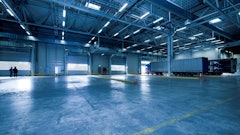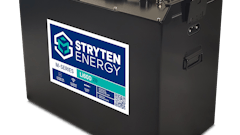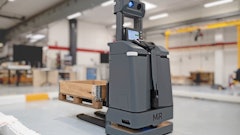
The newest models display improved electrical components and tip-resistant technology.
Lift trucks play an integral role in the daily operations of grocery distribution centers and foodservice warehouses. Managers know that conducting regularly scheduled maintenance can help extend the life of their trucks, but today’s manufacturers are helping with improved electrical systems and battery options.
Also boosting production capabilities are new comfort and safety features, which keep drivers injury-free and on the job day after day.
Dependability
With some facilities running up to three shifts seven days a week, it’s imperative to have equipment that can keep up with a demanding schedule.
Electronic component shortages can take a truck off the floor for more than a day. Lou Micheletto, warehouse products strategy manager, Yale Materials Handling Corp. of Greenville, NC, says “Typically in warehouse environments there’s a lot of dust and moisture in the air that can cause failures with the electronic connectors. So we use an IP-65, the highest-rated electrical connector, which is impervious to dust and low-pressure water, making it more dependable for the operation.”
Moisture is the natural enemy of any electrical device, but in frozen and cold storage applications, condensation is inevitable. To help prevent moisture damage, Toyota Material Handling USA Inc., Irvine, CA, has increased the moisture resistance of its electrical connections from 70 to 90 percent.
Recognizing the importance of electrical dependability, Toyota recently launched its 8-Series line of electric lift trucks with some improvements to their electrical system. The new trucks utilize Controller Area Network (CAN-bus) communication technology to provide precise, fast and reliable control of all truck functions with fewer electrical components. This technology greatly minimizes the chances of individual component failure.
Extended battery life can also keep lift-trucks operating longer. According to Susan Comfort, product manager of narrow aisle products, The Raymond Corp. of Greene, NY was the first company to pioneer the use of AC battery technology in lift trucks in North America. Raymond’s ACR System provides two primary advantages: increased energy efficiency and reduced maintenance costs.
“From an energy efficiency standpoint, the ACR System provides consistent performance as the battery discharges, so an operator won’t experience the deterioration of performance that occurs when using a DC system,” says Jason Smith, Raymond’s food industry segment manager,. “Increased performance means more time spent working and less downtime. One customer reported the ability to move 12 percent more pallets per hour and achieved 20 percent more operating time from each battery charge.”
Driving Productivity
It’s undeniable that a main factor driving productivity is the labor force itself. Comfortable operators are productive operators, so lift truck manufacturers have incorporated ergonomic designs into their trucks to ensure optimal productivity.
Maria Schwieterman, product manager for Crown InfoLink and Crown RR5700, Crown Equipment Corp., New Bremen, OH, says Crown is noted for its attention to operators.
“We realize an operator could be on their lift truck for eight to 10 hours a day, so it’s literally their office,” says Schwieterman. “People who sit or stand in one place for an extended period of time constantly shift their weight for relief. A feature such as an entry bar discourages operators from settling their feet outside the compartment.”
To make the cab more comfortable, and keep operators’ bodies fully inside the cab, Crown installs flexible floor boards to serve as shock absorbers. Crown also offers an S-Class series that allows drivers to fully operate the truck while sitting, standing or leaning, so he can change positions while remaining safe within the cab.
Tripping or falling while getting in and out of the lift truck may cause operators to miss work and file workers’ compensation claims.
“We’ve designed the new 8-Series 4-Wheel AC Electric with curvilinear overhead guard pillar legs to provide a wider opening for operator entry and exit,” says Cesar Jimenez, electric product planning manager, Toyota Material Handling USA Inc. “We’ve also lowered and widened the first step in so it feels more natural to enter and exit, and manufactured it out of heavy-duty punch plate steel, so if the operator’s shoes have dirt, mud or water on them, they have additional traction to help avoid slipping.”
In addition to comfort, improved safety features on lift trucks help keep operators injury-free and in attendance each day.
Safety Features
One of the highest safety concerns with lift trucks is tip-overs, which OSHA attributes as the second leading cause of fatalities among forklift operators. In 1999 Toyota developed its System of Active Stability (SAS). The technology has resulted in zero overturn fatalities for Toyota in the 10 years it has been collecting data.
The SAS is an electronic controlled system made of two key components to protect against lateral (side to side) and longitudinal (front to back) tipping: the Active Control Rear Stabilizer and the Active Mast Function Controller.
Lift trucks can easily tip from one slight turn if the mast is raised while traveling at high speeds. Using sensors, Toyota’s Active Control Rear Stabilizer helps reduce that possibility by sensing instability and locking the rear axle to widen the lift truck’s support area and increase lateral stability.
The Active Mast Function Controller helps operators handle loads at high heights. The feature automatically overrides the operator’s manual control, limiting the forward tilt of the mast—making it more difficult to spill a load or tip the lift truck over.
“Normally the mast can tilt forward five to eight degrees, which could equal 10 inches of movement and result in the teeter-totter effect,” says Toyota’s Jimenez. “SAS senses the height and weight of the load being handled and limits the tilt to only one degree.”
Jungheinrich, headquartered in Hamburg, Germany, a Mitsubishi Caterpillar Forklift America Inc. (MCFA) partner, also offers a system that assists in reducing tip-overs.
Jeff Bowles, manager, warehouse product marketing, says “Jungheinrichs’s patented reach cushioning feature stabilizes the mast during the end stroke of the reach function, minimizing the forward forces at the top of the mast when reaching. The result is a substantial reduction in mast and load sway, even at very high lift heights, reducing the potential for product damage from inadvertent contact with the racking, improving operator confidence and overall productivity.”
Even with added safety features, nothing can compare to a well-trained operator. Crown offers data management tools to make sure only properly trained staff can operate equipment.
“We have a product called InfoLink, which requires operators to log into their truck before driving it,” says Crown’s Schwieterman. “This ensures only licensed operators use the truck because if they’re not trained, or not recently trained, it will not let them operate.”
As the needs of food warehouses and distribution centers evolve, lift truck manufacturers strive to anticipate their customers’ next requests. Staying one step ahead of the curve, leading lift truck manufacturers have answered the industry’s call for improved dependability, durability and safety.
Top Six Fleet Maintenance Pointers By Pat DeSutter
Implement a dynamic replacement program: A sound replacement program identifies the specific break-even point where the maintenance costs of the asset will exceed the ownership costs. At this point, it is more economical to replace the asset. Numerous factors drive this decision including the severity of the application, rate of usage, type of truck and the type of maintenance it receives.
Have a maintenance program in place: One of the most critical elements to ensure you are getting optimal use and productivity out of your lift truck is to have a maintenance program in place and to monitor the program. At a minimum you should have a periodic maintenance program established that ensures that all critical areas of the truck are maintained to manufacturer recommendations and specifications.
Know your maintenance costs: You cannot manage what you do not measure. Having good baseline data is the first step toward understanding your real maintenance expenses at the asset level, which enables you to set specific goals for cost reduction.
Don’t turn a blind eye to avoidable damage: In many environments, avoidable damage associated with operator abuse can be as much as 35 to 40 percent of the total cost to maintain the lift truck. Use of maintenance tracking software and telemetry will provide the insights you need to attack and reduce this very costly aspect of maintaining your lift truck asset. Often an operator training program or review of processes will reveal corrective action opportunities to reduce these costs.
Aged assets and downtime: Not only will the maintenance costs increase as the asset ages, but factors such as parts obsolescence and increased opportunity for major repairs can contribute to significant downtime resulting in lost productivity. This is an often overlooked factor.
Consider partnering for competitive advantage: If you struggle with any of the above areas, consider enlisting the services of a quality fleet management partner. A fleet management provider can work as an extension of your operation to address and provide recommendations for each of these areas. Additionally, it can perform work order review and assessment, as well as help you compress administrative costs through providing centralized service call management and invoicing, to name just a few services available.
DeSutter is director fleet management, NACCO Materials Handling Group (NMHG), Greenville, NC.
Vendor Listing
• Crown, New Bremen, OH;
www.crown.com
• Jungheinrich, Hamburg, Germany;
www.jungheinrich-us.com
• Yale, Greenville, NC;
northamerica.yale.com
• Raymond, Greene, NY;
www.raymondcorp.com
• Toyota, Irvine, CA;
www.toyotaforklift.com





























